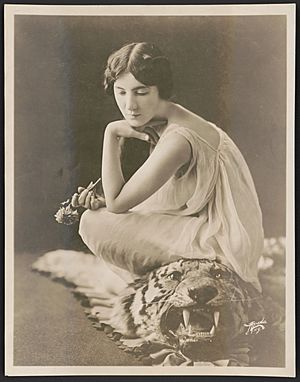Audrey Munson facts for kids
Quick facts for kids
Audrey Munson
|
|
|---|---|

Munson with Buzzer the cat in 1915
|
|
| Born |
Audrey Marie Munson
June 8, 1891 Rochester, New York, U.S.
|
| Died | February 20, 1996 (aged 104) Ogdensburg, New York, U.S.
|
| Resting place | New Haven Cemetery |
| Nationality | American |
| Occupation | Artist's model, actress |
| Years active | 1909–1921 |
Audrey Marie Munson (born June 8, 1891 – died February 20, 1996) was an American artist's model and film actress. Many people called her "America's first supermodel." During her time, she was known by several nicknames like "Miss Manhattan" and "American Venus." She was the inspiration for more than twelve statues in New York City and many others elsewhere. Audrey Munson also acted in four silent films.
Contents
Her Life and Career
Becoming a Model
Audrey Marie Munson was born in Rochester, New York on June 8, 1891. Her parents were Edgar Munson and Katherine "Kittie" Mahaney. When Audrey was eight, her parents divorced. She and her mother then moved to Providence, Rhode Island.
In 1909, when Audrey was 17, she and her mother moved to Washington Heights, Manhattan in New York City. Audrey wanted to become an actress or a dancer. She appeared in a few Broadway shows, like The Boy and The Girl.
One day, while shopping, Audrey was noticed by a photographer named Felix Benedict Herzog. He asked her to pose for him. Herzog then introduced her to his friends in the art world. She began posing for famous artists, including painters and illustrators. But she mostly posed for sculptors.
Audrey's first big modeling job was for a marble statue called Three Graces. This statue was shown at the Hotel Astor in New York City in 1909. She posed for all three figures in the statue. Soon after, Audrey became the top choice for many American sculptors. She posed for many statues, monuments, and sculptures on important public buildings.
By 1913, she was so well-known that people called her "Miss Manhattan." In 1915, she became the main model for Alexander Stirling Calder. He was in charge of all the sculptures for the Panama–Pacific International Exposition in San Francisco. Audrey's figure was used many times on one building alone. She posed for most of the sculptures at this big event. This made her famous as the "Panama–Pacific Girl."
Acting in Films
Audrey's fame as a model helped her start a career in movies. She starred in four silent films. Her movies did well at the box office, but critics had different opinions about them.
Her second film, Purity (1916), is the only one of her movies that still exists today. It was made by the American Film Manufacturing Company in California. Her third film, The Girl o' Dreams, was completed in 1916. However, it might not have been released to the public.
Audrey returned to the East Coast in late 1916. There were stories that her mother said Audrey married a very rich man, Hermann Oelrichs Jr.. However, there is no official record of this marriage.
Public Attention and Later Life
Around 1919, Audrey Munson was living with her mother in New York City. She continued to get attention from newspapers. By 1920, Audrey was finding it hard to get work. She was reported to be living in Syracuse, New York, and her mother supported them by selling kitchen tools.
From 1921, a series of twenty articles appeared in Hearst's Sunday Magazine. These articles were written under Audrey's name and were called By the 'Queen of the Artists' Studios'. They shared stories from her modeling career.
Later that year, a producer named Allen Rock advertised that he had paid Audrey a lot of money to star in a fourth film called Heedless Moths. This movie was based on her magazine stories. Audrey later said the check was just a "publicity stunt." She even sued Allen Rock. It was then revealed that a journalist had actually written the articles for her.
In the summer of 1921, Audrey Munson started a search across the country for the "perfect man" to marry. The United Press news agency reported on her search. However, she ended the search in August, saying she didn't want to get married after all.
On her 40th birthday, June 8, 1931, a judge ordered Audrey to be admitted to a mental asylum. She stayed at the St. Lawrence State Hospital for the Insane in Ogdensburg, New York for 65 years. She passed away there on February 20, 1996, at the age of 104.
Audrey had no visitors at the hospital for over 25 years after her mother died in 1958. But in 1984, her half-niece, Darlene Bradley, found her. Audrey was 93 at the time. She was later moved to a nursing home and then back to a new mental institution. Audrey Munson was buried at New Haven Cemetery in New Haven, New York. She received a headstone for her grave on June 8, 2016, which would have been her 125th birthday.
Filmography
All four films Audrey Munson appeared in were thought to be lost for a long time. However, a copy of Purity (1916) was found in France in 2009.
| Year | Title | Role | Notes |
|---|---|---|---|
| 1915 | Inspiration | The Model | Also known as The Perfect Model (1918) |
| 1916 | Purity | Purity / Virtue | |
| 1916 | The Girl o' Dreams | Norma Hansen | |
| 1921 | Heedless Moths | Audrey Munson | Based on stories and articles written for Hearst's Sunday Magazine |
In 2010, a film director named Roberto Serrini made a documentary about Audrey Munson. This documentary was featured in several news outlets.
Images for kids
See Also
 In Spanish: Audrey Munson para niños
In Spanish: Audrey Munson para niños




